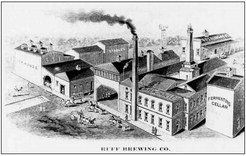Brewer's invention transformed beer industry

At one time it is believed that the Ruff Brewing Company was Quincy’s second largest brewery, producing about half the volume of Dick’s Brewing Company.
What makes the Ruff Brewing Company famous worldwide is not its beer, but an inventive family member.
Casper Ruff (or “Rouff” as it was sometimes spelled) was born in Weiler, Alsace. In 1837, like many of his era, Ruff set out for opportunity in America.
In 1855, Ruff purchased property at 12th and Adams in Quincy. He erected a brewery at that site. This location was chosen because “nearby springs provided clear and cold water.”
Initially, the business was dubbed the Union Brewery. Ruff, one of Quincy’s pioneer brewers, died in 1873. In 1882, the brewery was incorporated and became known as the Ruff Brewing Company.
While Casper Ruff would be known for years as opening one of Quincy’s first breweries, it would be his grandson, William J. Ruff, who made the family business well known. William was a pioneer in beer pasteurization.
On Jan. 28, 1865, William Ruff was born in Quincy to John and Annie Ruff. William received his education in the parochial schools of Quincy.
He was a natural student and would be considered a prodigy by any standard. Amazingly, he entered the Gem City Business College at age 12. Three years later he postponed his formal education because of the death of his father. William entered the brewing business as an apprentice, carefully learning the trade of his father and grandfather. As he demonstrated with his success in school, William mastered the various branches of the brewing trade in just three years.
Always craving for the opportunity to learn, William made a brewing pilgrimage to Germany to study the chemistry of brewing. He left Quincy on May 16, 1883, and made his way to Worms, Germany, where he studied. It was at this time that William made what would become his most famous discovery and, in time, secure the Ruff Brewing Company its place in brewing history.
William “conceived the idea of pasteurizing beer by automatic control of the process.” For a short time, William remained in Germany as an instructor, teaching his groundbreaking pasteurization method.
Upon his return to Quincy, William assumed the role of superintendent and brew master of his family’s brewery. William was eager to implement his pasteurization process at home. On July 19, 1898,
William Ruff would be awarded a patent for his pasteurization method.
According to his patent specifications, William’s new method sought to improve and streamline the pasteurization process of bottled beer. According to his patent filing, when beer is normally produced and ready for market it must be sufficiently preserved until it can reach the consumer. Some brewers used chemicals; others used pasteurization, whereby the beer was heated with steam or water to a certain temperature. This increased temperature would sterilize the beer before shipment. William believed this process was inefficient because when beer was heated too quickly, the bottles would shatter. Likewise, once the beer was sufficiently heated it needed to be cooled; however, if the beer was cooled too quickly, the bottles would shatter. Therefore, cooling had to be done gradually,
and this exposed the beer to the damaging effects of heat, which compromised taste.
William’s patented invention consisted of a tank and various pipes and valves. The bottled beer was placed in the tank, which was filled with water. Steam was then introduced, which caused a circulation of water through the tank and the pipes surrounding the bottled beer. This circulation of water was continuous and allowed the bottled to be heated gently to the desired temperatures.
Similarly, once heated to the optimum level for pasteurization, the tank drained the hot water, while gradually introducing cold water in the same manner that cooled the bottles quickly without breaking them.
William Ruff’s patented machine would become known industry-wide as Auto-Positive Ruff Pasteurizer Machine, Patent No. 607,770.
William Ruff refused to sit idle, and in 1917 he again applied for and was granted a patent for an improved
barrel for shipping
beer and other bottled liquids. This improved barrel included a removable top, which allowed the beer to be removed much more easily and greatly increased the life of the barrel, saving the brewing company money.
William Ruff’s inventions were not limited to the beer making industry. During World War I, he took an interest in improving safety devices in aeronautics. William invented a quick-opening, variable-speed parachute. He also attempted to invent a method for preventing airplanes from catching fire.
In 1906, William Ruff assumed management of the Ruff Brewing Company and equipped it with the best technology. Under his leadership, the company saw many profitable years.
With Prohibition, the company was forced to close. Once Prohibition ended, the company reopened. However, like many breweries of the time, the Ruff Brewing Company could not survive
the
post-Prohibition
industry competition.
In 1925, William Ruff died, and the Ruff Brewing Company was eventually purchased at public auction in 1927 for $30,000.
According to “Breweries of Quincy, IL – 1837-1850,” William Ruff’s patented pasteurization method “revolutionized the industry by preserving beer without the use of chemicals.” It would find its way into the “largest breweries in the United States, Japan, Mexico, Brazil, and South Africa.”
William Ruff loved Quincy and was highly involved in the Park and Boulevard Association, and was “influential in raising the first money for the purchase of South Park.”
While other breweries in Quincy may be better known, the inventions of William Ruff transformed the beer making industry and forever cemented his legacy as one of Quincy’s greatest inventors.
Jeff Terry is a native of Quincy and a lawyer with Schmiedeskamp, Robertson, Neu & Mitchell LLP. He is a member of the board of directors of the Historical Society of Quincy and Adams County.






